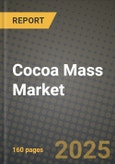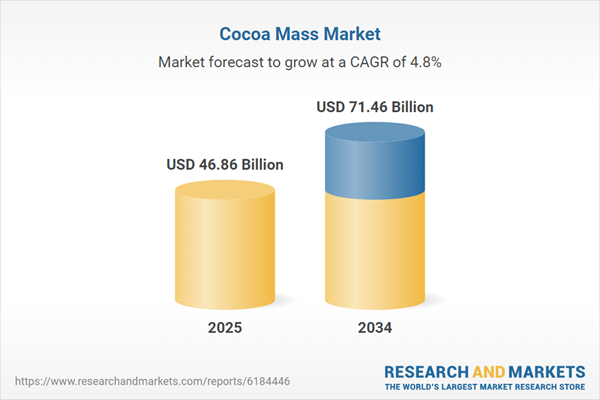Cocoa Mass Market
Cocoa mass - also called cocoa liquor - is the foundational, non-alcoholic paste produced by grinding roasted cocoa nibs and is the essential input for dark, milk, and compound chocolates, fillings, spreads, bakery coatings, and premium ice-cream inclusions. Demand is anchored by global confectionery majors and a widening base of artisanal and private-label chocolatiers, while foodservice, bakery, and plant-based dessert brands deepen industrial offtake. Recent cycles feature sharper upstream volatility driven by weather extremes, crop disease pressure, farm-gate policy shifts, and stricter traceability/deforestation rules, all of which elevate supply assurance and sustainability premiums. On the demand side, mix is tilting toward higher-cocoa solids, origin-specific, and ethically certified lines, with branding increasingly built on farm-to-bar narratives, transparency, and quality differentials. Competitive dynamics remain concentrated among integrated grinders/processors who manage origination, primary processing, risk hedging, and quality standardization, while nimble mid-sized grinders in Asia and Latin America expand contract manufacturing and origin processing footprints. Strategic priorities include digitized traceability to plot level, farmer income uplift programs, agroforestry adoption, and resilience in sourcing portfolios beyond West Africa. Product innovation focuses on flavor consistency, reduced off-notes, customized fat profiles through liquor selection, and ready-to-melt formats (blocks, chips, liquid tankers) that optimize customer throughput. Operationally, companies are optimizing roasting/grinding/refining energy intensity, improving liquor storage stability, and tightening specifications for viscosity, particle size distribution, and flavor chemistry to meet exacting brand recipes. Overall, the market is evolving from volume-led supply chains to value-differentiated, compliance-ready networks, where quality governance, sustainability credibility, and risk management define competitive edge.Cocoa Mass Market Key Insights
- Supply concentration & resilience. Harvests remain concentrated in West Africa, exposing processors to correlated climate and disease risks. Leading grinders are diversifying origin baskets (e.g., Latin America, emerging African origins) and deploying agronomy support to stabilize bean quality. Multi-origin blending strategies safeguard flavor specs while moderating single-origin exposure. Contracting models emphasize long-term relationships and shared risk.
- Traceability as a license to operate. End-to-end traceability - from farm polygon mapping to batch-level liquor lots - has shifted from differentiation to necessity. Companies are scaling digital tools, geo-verification, and supplier onboarding to meet due-diligence laws. Customer audits increasingly require plot-level evidence and segregation or mass-balance control. Traceability readiness now influences tender awards and pricing.
- Sustainability premiums & program depth. Buyer preferences favor liquor backed by deforestation-free, child-labor remediation, and living-income programs. Premiums hinge on credible verification, program coverage, and impact metrics. Agroforestry and climate-smart practices are prioritized to improve yield stability and shade management. Brands translate program depth into pack claims and portfolio tiering.
- Quality architecture & flavor stewardship. Liquor specification spans bean genetics, fermentation protocols, roast curves, and particle size distribution. Consistent flavor chemistry and low astringency underpin premium contracts. Processors invest in sensorial panels and inline analytics to reduce batch variability. Origin-specific lines serve the craft and premium segments.
- Format and logistics optimization. Customers demand flexible formats - liquid tankers for large plants; blocks/chips for mid-size and artisanal users. Temperature-controlled supply chains and storage stability are critical. Melt behavior and viscosity are tuned for enrobing, molding, and compound integration. Packaging re-design targets line efficiency and waste reduction.
- Risk management & pricing practices. Futures hedging, basis management, and structured contracts offset raw-bean volatility. Processors align hedge horizons with customer call-offs and recipe cycles. Price-to-service models incorporate sustainability, traceability, and quality premiums. Strategic inventories cushion short-term shocks but require disciplined working-capital control.
- Regulatory tightening & compliance costs. Expanding due-diligence and deforestation regulations raise documentation and monitoring requirements. Suppliers without verified supply chains face delist risk. Compliance readiness is now a competitive moat and a procurement gate. Processors are standardizing evidence packs to simplify customer audits.
- Premiumization and mix shift. Growth skews toward dark chocolate, higher-cocoa-solids SKUs, and origin-labeled lines. Artisanal and specialty chocolatiers pull through smaller lots with tighter specs. Foodservice/bakery require stable flavor and flow profiles for coatings and fillings. Clean-label and minimal processing narratives support cocoa-forward recipes.
- Origin processing & local value addition. Investment in grinding capacity near origin reduces freight, strengthens bean access, and supports government industrialization goals. Origin plants must overcome utilities reliability and certification infrastructure. When executed well, they improve freshness, flavor integrity, and sustainability storytelling.
- Technology enablement & operational efficiency. Advanced roasting controls, predictive maintenance, and inline rheology/particle analytics lift yield and consistency. Energy optimization lowers cost and emissions. Digital supplier portals streamline farmer payments and data capture. CQV (continuous quality verification) reduces rework and claims.
Cocoa Mass Market Reginal Analysis
North America
Market demand is shaped by premium chocolate, artisanal bakery, and better-for-you snacks that rely on intense cocoa flavor with clean labels. Large confectioners emphasize long-term contracts, sustainability-verified mass, and contingency blends to manage bean variability. Specialty chocolate makers source terroir-driven liquors and require small-batch consistency. Retailers and foodservice buyers scrutinize traceability claims and push for lower-carbon logistics and packaging. Private label expands in premium formats, creating opportunities for flexible, segregated supply.Europe
Regulatory rigor defines procurement, prioritizing deforestation-free and human-rights due diligence with geolocated farm data. Buyers favor segregated or identity-preserved cocoa mass supporting single-origin and organic lines. Historic grinding hubs maintain technical leadership, while origin grinding partnerships deepen. Premium dark chocolate, patisserie, and gelato sustain demand for flavor-forward liquors. Sustainability scorecards influence supplier selection, and Scope 3 targets accelerate energy-efficient processing and modal shift in freight.Asia-Pacific
Rising middle-class consumption and modern retail expansion lift chocolate and bakery penetration. Multinationals and regional brands scale local production, balancing imports with domestic grinding in Southeast Asia. Japan and South Korea drive demand for high-spec liquors and precise rheology; Australia and New Zealand focus on clean label and premium treats. Emerging e-commerce confectionery channels enable rapid NPD cycles, while foodservice desserts and beverages broaden cocoa mass applications.Middle East & Africa
Urbanization and tourism support premium desserts, bakery, and chocolate gifting, particularly in the Gulf. Local confectionery manufacturing grows, sourcing both standard and specialty liquors with an emphasis on heat-resilient formulations for warm climates. African origin countries advance grinding to capture value at source, supported by industrial parks and logistics upgrades. Certification and traceability programs expand, improving access to European and premium export customers.South & Central America
Strong origin credentials (notably fine-flavor beans) underpin single-origin and specialty cocoa mass positioning. Regional processors leverage proximity to distinctive varietals to deliver nuanced flavor profiles for gourmet and bean-to-bar segments. Domestic chocolate categories premiumize, while exports benefit from compliance investments and improved port logistics. Partnerships between farmer cooperatives and grinders enhance quality control, fermentation standards, and consistent supply for international buyers.Cocoa Mass Market Segmentation
By Type
- Organic
- Conventional
By Form
- Solid Form
- Semi-solid Form
By Application
- Confectionery
- Bakery
- Ice Cream
- Desserts
- Others
By Distribution Channel
- Supermarket
- Online Store
- Convenience Store
- Others
Key Market players
Barry Callebaut, Cargill Cocoa & Chocolate, ofi (Olam Food Ingredients), ECOM Cocoa Group, Blommer Chocolate Company (Fuji Oil Group), Guan Chong Cocoa (GCB Cocoa), JB Cocoa, BT Cocoa (Bumitangerang Mesindotama), Niche Cocoa, Cocoa Processing Company (CPC) Ghana, Touton Cocoa, CÉMOI Group, Sucden Cocoa, Moner Cocoa, Natra CacaoCocoa Mass Market Analytics
The report employs rigorous tools, including Porter’s Five Forces, value chain mapping, and scenario-based modelling, to assess supply-demand dynamics. Cross-sector influences from parent, derived, and substitute markets are evaluated to identify risks and opportunities. Trade and pricing analytics provide an up-to-date view of international flows, including leading exporters, importers, and regional price trends.Macroeconomic indicators, policy frameworks such as carbon pricing and energy security strategies, and evolving consumer behaviour are considered in forecasting scenarios. Recent deal flows, partnerships, and technology innovations are incorporated to assess their impact on future market performance.
Cocoa Mass Market Competitive Intelligence
The competitive landscape is mapped through proprietary frameworks, profiling leading companies with details on business models, product portfolios, financial performance, and strategic initiatives. Key developments such as mergers & acquisitions, technology collaborations, investment inflows, and regional expansions are analyzed for their competitive impact. The report also identifies emerging players and innovative startups contributing to market disruption.Regional insights highlight the most promising investment destinations, regulatory landscapes, and evolving partnerships across energy and industrial corridors.
Countries Covered
- North America - Cocoa Mass market data and outlook to 2034
- United States
- Canada
- Mexico
- Europe - Cocoa Mass market data and outlook to 2034
- Germany
- United Kingdom
- France
- Italy
- Spain
- BeNeLux
- Russia
- Sweden
- Asia-Pacific - Cocoa Mass market data and outlook to 2034
- China
- Japan
- India
- South Korea
- Australia
- Indonesia
- Malaysia
- Vietnam
- Middle East and Africa - Cocoa Mass market data and outlook to 2034
- Saudi Arabia
- South Africa
- Iran
- UAE
- Egypt
- South and Central America - Cocoa Mass market data and outlook to 2034
- Brazil
- Argentina
- Chile
- Peru
Research Methodology
This study combines primary inputs from industry experts across the Cocoa Mass value chain with secondary data from associations, government publications, trade databases, and company disclosures. Proprietary modeling techniques, including data triangulation, statistical correlation, and scenario planning, are applied to deliver reliable market sizing and forecasting.Key Questions Addressed
- What is the current and forecast market size of the Cocoa Mass industry at global, regional, and country levels?
- Which types, applications, and technologies present the highest growth potential?
- How are supply chains adapting to geopolitical and economic shocks?
- What role do policy frameworks, trade flows, and sustainability targets play in shaping demand?
- Who are the leading players, and how are their strategies evolving in the face of global uncertainty?
- Which regional “hotspots” and customer segments will outpace the market, and what go-to-market and partnership models best support entry and expansion?
- Where are the most investable opportunities - across technology roadmaps, sustainability-linked innovation, and M&A - and what is the best segment to invest over the next 3-5 years?
Your Key Takeaways from the Cocoa Mass Market Report
- Global Cocoa Mass market size and growth projections (CAGR), 2024-2034
- Impact of Russia-Ukraine, Israel-Palestine, and Hamas conflicts on Cocoa Mass trade, costs, and supply chains
- Cocoa Mass market size, share, and outlook across 5 regions and 27 countries, 2023-2034
- Cocoa Mass market size, CAGR, and market share of key products, applications, and end-user verticals, 2023-2034
- Short- and long-term Cocoa Mass market trends, drivers, restraints, and opportunities
- Porter’s Five Forces analysis, technological developments, and Cocoa Mass supply chain analysis
- Cocoa Mass trade analysis, Cocoa Mass market price analysis, and Cocoa Mass supply/demand dynamics
- Profiles of 5 leading companies - overview, key strategies, financials, and products
- Latest Cocoa Mass market news and developments
Additional Support
With the purchase of this report, you will receive:- An updated PDF report and an MS Excel data workbook containing all market tables and figures for easy analysis.
- 7-day post-sale analyst support for clarifications and in-scope supplementary data, ensuring the deliverable aligns precisely with your requirements.
- Complimentary report update to incorporate the latest available data and the impact of recent market developments.
This product will be delivered within 1-3 business days.
Table of Contents
Companies Mentioned
- Barry Callebaut
- Cargill Cocoa & Chocolate
- ofi (Olam Food Ingredients)
- ECOM Cocoa Group
- Blommer Chocolate Company (Fuji Oil Group)
- Guan Chong Cocoa (GCB Cocoa)
- JB Cocoa
- BT Cocoa (Bumitangerang Mesindotama)
- Niche Cocoa
- Cocoa Processing Company (CPC) Ghana
- Touton Cocoa
- CÉMOI Group
- Sucden Cocoa
- Moner Cocoa
- Natra Cacao
Table Information
| Report Attribute | Details |
|---|---|
| No. of Pages | 160 |
| Published | November 2025 |
| Forecast Period | 2025 - 2034 |
| Estimated Market Value ( USD | $ 46.86 Billion |
| Forecasted Market Value ( USD | $ 71.46 Billion |
| Compound Annual Growth Rate | 4.8% |
| Regions Covered | Global |
| No. of Companies Mentioned | 15 |









